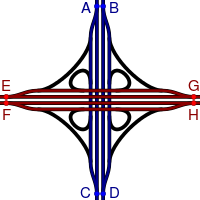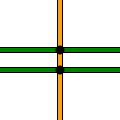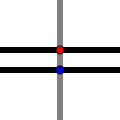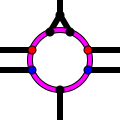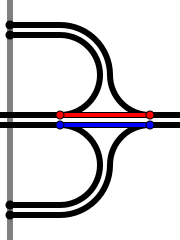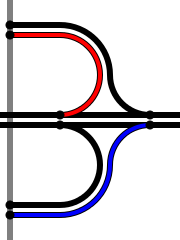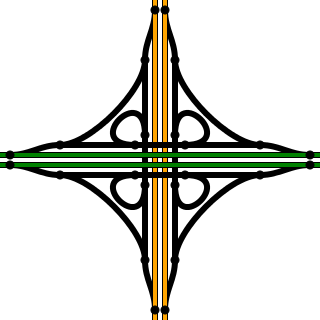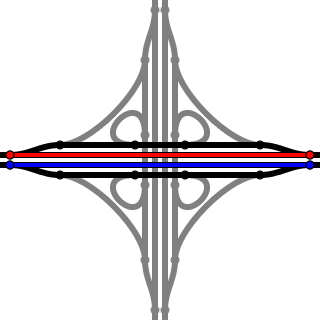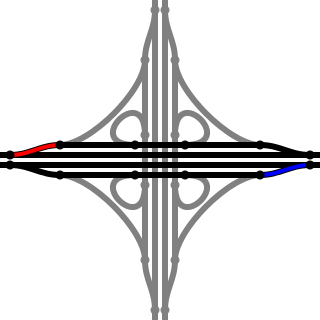Relation:tmc:point
| Description |
|---|
| TMC point location. |
| Group: highways |
| Members |
|
|
| Status: proposed |
| Tools for this tag |
|
A relation tagged with type=tmc:point describes a single Traffic Message Channel point location, which can be either an isolated point not connected to the road network, an intermediate point along a single road such as a bridge or tunnel, or a junction between several roads. Each TMC point location, which is uniquely identified by a country ID, table code and location code in the location code list and has class "P" for point, should correspond to exactly one TMC point relation in OSM. Some places, such as motorway intersections, have more than one location code - one for each motorway. These should be mapped using more than one TMC point relation, one for each location code.
Tags
| Key | Value | Explanation | Example |
|---|---|---|---|
| Basic tags | |||
| type | tmc:point | Indicates that this relation represents a TMC point location. | tmc:point |
| table | country ID and table code | Country ID (cid) and table code (tabcd) of the TMC Location Code List which contains this location. The values are separated with a colon in the form "{cid}:{tabcd}". | 58:1 |
| version | table version | Version of the TMC location table according to which this point has been mapped. | 13.0 |
| lcd | location code | Location code in the range 1 - 63487 of this TMC point. | 12345 |
| class | location class, type, subtype | Class, type and subtype of this TMC point in the form "{class}{type}.{subtype}". For point locations {class} is always the letter P, while {type} and {subtype} are numbers. See TMC/Location Code List/Location Types#Points for a list of possible values. | P1.2 |
| Names and references | |||
| name | name | Name of this TMC point. This is usually the name found in the location table in the field n1id, but can also be modified, if appropriate. | Hannover-Ost |
| intersects | name of intersecting road | If this point marks an intersection or motorway junction, and the intersected road has a name, this tag may contain the name of the intersected road. This is usually found in the field n2id of the location table. | Rötgesbütteler Landstraße |
| road_name | road name | Name of the road to which this TMC point point belongs. This can be found in the field rnid of the location table, but modifications are possible. | Friedensallee |
| road_ref | road reference number | Reference number of the road to which this TMC point point belongs. This can be found in the field roadnumber of the location table. | A 23 |
| junction_ref | junction reference number | Locations such as motorway junctions usually have a reference number which enumerates the junctions along a motorway. This can be found in the field junctionnumber of the location table. | 17 |
| Presence depending on direction | |||
| present | positive / negative / both | Indicates whether this TMC point location (such as a service or rest area) is present / available to drivers driving in either direction or not. The default is "both". Other values indicate whether the driver must be driving in positive or negative TMC direction to access / use this feature. | positive |
| Offsets | |||
| pos_offset | positive offset | Location code of the neighbouring TMC point in the positive road direction. This can be found in the field pos_off_lcd in the location table. | 12346 |
| neg_offset | negative offset | Location code of the neighbouring TMC point in the negative road direction. This can be found in the field neg_off_lcd in the location table. | 12344 |
| Links to other TMC locations | |||
| road_lcd | road location code | Location code of the TMC road to which this TMC point belongs, if any. This can be found in the field roa_lcd in the location table. | 1234 |
| seg_lcd | segment location code | Location code of the TMC segment to which this TMC point belongs, if any. This can be found in the field seg_lcd in the location table. | 4321 |
| area_lcd | area location code | Location code of the TMC area to which this TMC point belongs, if any. This can be found in the field pol_lcd or oth_lcd in the location table. | 123 |
Members and roles
A tmc:point relation may contain two different types of members: junction nodes and ways along the road / carriageway which are used for navigation, and elements of infrastructure such as parking lots or gas stations, which may be affected by TMC messages. Roles are used to distinguish between elements on the main carriageway and on slip roads and different types of infrastructure. They further describe on which side of the road these elements are located, either in the positive or negative TMC direction, or both.
Roles are generically of the type {direction}:{description}, where {direction} is one of the values "positive", "negative" or "both" and indicates on which side of the road this element is located, i.e., whether it may be used by drivers driving into the positive, negative or either direction. {description} indicates whether this element is part of the road or the infrastructure. The following table lists some possible values:
| {description} | Explanation |
|---|---|
| (empty) | This element is part of the main carriageway. In this case also the ":" is omitted from the role, so that the full role is only "positive", "negative" or "both". |
| entry | This element is part of an entry slip road which leads towards the road associated to this TMC point. |
| exit | This element is part of an exit slip road which leads away from the road associated to this TMC point. |
| ramp | This element is part of a bidirectional slip road connected to this TMC point. |
| parking | Parking areas, parking aisles and driveways towards these areas. |
| fuel | Gas stations and associated driveways. |
| restaurant | Dining places and associated driveways. |
| traffic_signal | This node element is the traffic signals at this crossing TMC point. |
Examples
The following examples show which elements (nodes and ways) to include in a TMC point relation and which roles should be assigned to these members. The pictures show the situation for right-sided traffic.
Junction between segregated and non-segregated road
This example shows a junction between a segregated road (green) with a non-segregated road (orange). The positive direction of the segregated road is to the left, and of the non-segregated road to the top. If both roads are in the TMC road network, this junction has two TMC location codes, since it is an element of two roads, and therefore should be mapped using two TMC point relations, one for each location code. In the following the members of these TMC point relations are shown.
| TMC point on the segregated road | |
|---|---|
| A driver on the segregated road passes by only one node at which he can enter or leave the road, either the red or blue node, depending on his driving direction. The red node (positive driving direction) is added to the TMC point relation with role positive, while the blue node (negative driving direction) is added with role negative. | |
| TMC point on the non-segregated road | |
| The nodes where one can enter or leave this road are added to the TMC point relation with role both, since they are passed by in either driving direction. The way between these two nodes is also added to the relation with role both. Here the roles can also be omitted, since both is the default if there is only one role in the relation. | |
Roundabout between segregated and non-segregated road
In this example the junction between the segregated road (green) and the non-segregated road (orange) has been replaced by a roundabout. The positive direction of the segregated road is to the left, and of the non-segregated road to the top. If both roads are in the TMC road network, this junction has two TMC location codes, since it is an element of two roads, and therefore should be mapped using two TMC point relations, one for each location code. In the following the members of these TMC point relations are shown.
| TMC point on the segregated road | |
|---|---|
| A driver on the segregated road passes by one node where he enters the roundabout and one where he leaves the roundabout, either the red or blue nodes, depending on his driving direction. The red nodes (positive driving direction) are added to the TMC point relation with role positive, while the blue nodes (negative driving direction) are added with role negative. The roundabout way is passed in any driving direction and is added to the TMC point relation with role both. | |
| TMC point on the non-segregated road | |
| In this example the lower roundabout exit has only one node which is passed by in any driving direction and is added to the TMC point relation with role both. The upper roundabout exit is split into separate entry and exit ways. Here the common node which is passed by in both driving directions is added with role both. The entry way and the node at which the roundabout is entered, which are passed by only in the negative driving direction (blue), are added with role negative. The exit way and the node at which the roundabout is left, which are passed by only in the positive driving direction (red), are added with role positive. The roundabout way is passed in any driving direction and is added to the TMC point relation with role both. | |
Motorway junction with non-segregated road
This example shows a junction between a motorway (green) with a non-segregated road (orange) and separate slipways for entries and exits. The positive direction of the motorway is to the left, and of the crossing road to the top. If both roads are in the TMC road network, this junction has two TMC location codes, since it is an element of two roads, and therefore should be mapped using two TMC point relations, one for each location code. In the following the members of these TMC point relations are shown.
Motorway intersection
This example shows an intersection between two motorways (green and orange). The positive directions of the motorways are to the left and to the top. A motorway intersection has typically two TMC location codes, since it is an element of two roads, and therefore should be mapped using two TMC point relations, one for each location code. The mapping is the same for each TMC point. In the following therefore only the members of one of these TMC point relations are shown.
